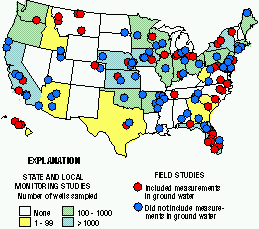National Water-Quality Assessment (NAWQA) Project
Go to:
Over 300 studies of pesticide occurrence in ground water and soils have been carried out during the past 30 years (see Figure 2). These studies include areas that range in scale from field plots of less than 1 square meter to large multistate regions. The largest of these studies to date was the National Pesticide Survey conducted by the U.S. Environmental Protection Agency in all 50 states from 1988 to 1990 (U.S. Environmental Protection Agency, 1990). Approximately half of the reviewed investigations included measurements of pesticide concentrations specifically made in ground water; most focused primarily on soils and tile drainage. About one third of the studies included analysis of the breakdown products formed by chemical or biological transformation of pesticides. Five investigations, including the National Pesticide Survey, sampled ground water for pesticides across regions encompassing more than one state. To date, statewide surveys of pesticide occurrence in ground water have been reported for at least 17 states.

The areas of the United States where ground waters have been monitored intensively for pesticides are those where agricultural pesticide use is most extensive: California, Florida, New York (especially Long Island), New England, the central Atlantic Coastal Plain, and the central and northern midcontinent. In the Rocky Mountain states and the arid southwest, where pesticide use is less extensive, sampling has been sparse and infrequent. With the exception of Florida, ground-water sampling for pesticides in the southeast and southern midcontinent has also been limited, in spite of extensive pesticide use. To date, there have been few studies of golf courses, urban areas, and other settings where non-agricultural use of pesticides may be high.